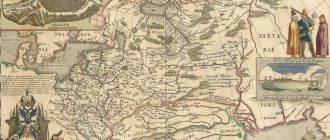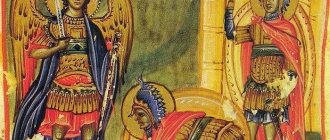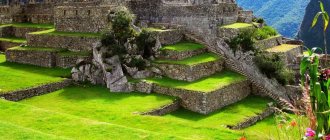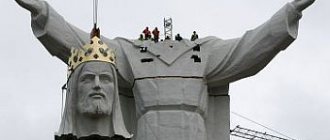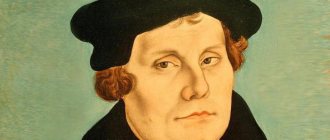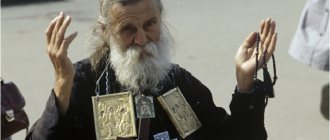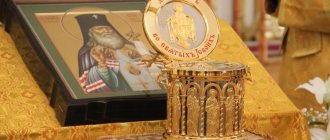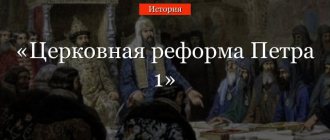Monasticism (from the Greek μόνος - one, united; μοναχός - living in solitude), a term used in Christianity and, by analogy with it, used in relation to a number of other religions; denotes a special form of life for believers who are completely devoted to following the spiritual path in order to achieve the ultimate goal of a particular religion. teachings. M. presupposes asceticism, renunciation of the world (renunciation of family, property), obedience to spiritual mentors, and organization of life according to special rules (see Monastic Rules).
Egypt - the birthplace of monasticism
Christian monasticism appeared at the border of the 3rd and 4th centuries. It then became an established institution in the Christian Church. The first Christian monks appeared in Egypt and Syria. They began to develop an enthusiasm for asceticism. The very first Christian monk was Saint Anthony. In the world he is considered the founder of Christian monasticism. The first monks were solitary figures. They sought self-isolation.
Some of them settled in tombs or abandoned buildings. Also, the first monks spent their time in caves and deserts. They fought there against desires and the flesh, as well as against the wiles of the devil. Some time later, more and more lonely hermit monks began to appear in the deserts. They began to gather together for daily obligatory prayers. The hermits led a pious lifestyle, attracting a large number of imitators and admirers with their holiness. Certain scriptures were created about this life. The spirit of monasticism increasingly embraced Christians. This was important for the development of the Church.
Monasticism as the highest stage of Christian development
The goal of a Christian’s ascent is one – a mysterious meeting with God, entry into communion with God. But different paths lead to this peak: one of them is gentler and longer - this is marriage, the other is steeper and shorter - this is monasticism. The life of the Forerunner and some of Christ’s apostles, as well as some episodes of the Gospels and Paul’s Epistles, speak of the possibility of quickly achieving this goal in celibacy. And the earthly ministry of the Savior could only be carried out unencumbered by ordinary family concerns. During monastic tonsure, the Gospel is read, composed of two passages that contain the entire “philosophy” of monastic life: Whoever loves father or mother more than Me is not worthy of Me; and whoever loves a son or daughter more than Me is not worthy of Me; and whoever does not take up his cross and follow Me is not worthy of Me... Come to Me, all you who labor and are heavy laden, and I will give you rest; take My yoke upon you and learn from Me, for I am meek and lowly in heart, and you will find rest for your souls; for My yoke is easy and My burden is light (Matthew 10:37-38; 11:28-30). The desire to “be perfect” includes the condition - “give all your possessions to the poor and follow Me” (cf. Matt. 19:16-22). Every Christian is called to a virtuous life, but only a monk is charged with the duty of an undivided desire for perfection. Every Christian is called to live according to the Gospel, but only a monk embodies the Gospel ideal in the most radical way, striving to imitate Christ in everything. Every Christian at baptism takes a vow of fidelity to God, but only a monk promises God to follow the path of complete non-covetousness, chastity and obedience. Every Christian is called to repent, but only for a monk crying should become an ongoing and daily feat. If the Lord commands a family man to observe chastity in marriage, not to commit adultery and not to look at women with lust, then from a monk He demands complete loneliness and complete abstinence from marriage. If the Lord commands a layman not to accumulate treasures on earth, but first of all to take care of the Kingdom of God, then a monk must generally renounce all earthly acquisitions, have nothing of his own, but give all of himself and all of himself to God. If a layman is commanded “not to love the world and what is in the world,” then the monk is called to completely renounce the world and hate it. Thus, monasticism appears as the most radical form of following Christ’s call to perfection, selflessness and bearing the cross. Monasticism is the good yoke of Christ, voluntarily placed upon oneself by a monk. It is the most complete imitation of the One who is meek and humble in heart, for whose sake the monk renounces his parents, relatives, and the whole world. This yoke of Christ is most clearly expressed in the vows that a person pronounces in front of the Church before accepting the “angelic image”:
staying in the monastery and fasting until the last breath, keeping oneself in virginity, chastity and reverence, obedience to the abbot and all the brethren in Christ, remaining until death in non-covetousness and voluntary poverty for the sake of Christ in common life, accepting all the rules of the monastic community, the rules of the holy fathers and orders of the abbot, readiness to endure all the tightness and sorrow of monastic life for the sake of the Kingdom of Heaven[4].
Taking these vows marks the entry into a new life, full of various exploits and struggles. The vow of chastity is not limited to maintaining only carnal purity, but also includes keeping the mind from thoughts and the heart from impure feelings. "Chastity" - Greek. σωφροσύνη - literally means “ sanity ”, guidance in all one’s actions and thoughts by the wisdom coming from above, which is Christ Himself – the Logos of God. Non-acquisitiveness means giving up the search for wealth, the desire for earthly goods. A monk has only what is necessary for life, and distributes the rest to those in need and never attaches his heart to anything earthly, so that his mind is always free from worries about vain and worldly things, but is busy caring about his own salvation and the salvation of his neighbor. The “Ladder” and other monuments of ascetic writing speak of the virtue of wandering, when a person understands that he does not have a permanent city here on earth, but seeks the future, because his spiritual homeland is Heavenly Jerusalem. And it is to him that the monk’s spiritual gaze is directed. Obedience is of particular importance . This is a feat that is difficult for modern people to understand and accept, and yet this is precisely the essence of monastic work. Obedience is the basis of monasticism, writes the great ascetic of our time, Archimandrite Sophrony Sakharov. – Monasticism is, first of all, purity of mind. Without obedience it is impossible to achieve it, and therefore without obedience there is no monasticism. A disobedient person is not a monk in the true sense of the word. Outside of monasticism, it is possible to achieve the great gifts of God, up to martyrdom, but purity of mind is a special gift to monasticism, unknown on other paths, and a monk knows this state only through the feat of obedience. Obedience to a spiritually experienced mentor makes it easier for a monk to perceive monastic science. Only those who have completed this school are able to subsequently become a mentor for the next generation of monks. Obedience is the grave of one’s own will and the resurrection of humility, says Saint John Climacus. - He who is obedient, like a dead man, does not contradict and does not reason, neither in good nor in what may seem evil to him; for the one who piously killed his soul is responsible for everything[5]. The constant and most important activity of a monk, which supports him in fulfilling his vows, is prayer, his spiritual weapon. Therefore, in the monastic rules, various prayers are distributed throughout the day in the temple and in the cell, general and individual. A monk, constantly being in prayer, must approach the Holy Mysteries of Christ as often as possible in order to unite with the Divine nature of Christ, in order to lead the life of the next century here on earth. A monk’s inner mood should be inextricably linked with repentance and lamentation. At the very beginning of tonsure into the minor schema, the abbot, calling to him the tonsured man who has humbled himself to the ground, says: Wise God, like a loving Father, your humility and true repentance are in vain, child, like the prodigal son, accepts you repentant and falls to Him with all your heart. A monk undertakes the feat of repentance not because he is more sinful than other people, but because he chooses repentance for himself as a way of life. The Monk Isaac the Syrian speaks about monasticism as a path of mourning: That monk (Sir. abila - literally “weeping”) who, in the hope of future blessings, spends all the days of his life in greed and thirst. He is a monk who is outside the world and always prays to God to receive future benefits for him. The monk’s wealth is the consolation found in crying...[6] But in this constant contrition the monk also finds spiritual joy, which is born from crying and repentance. In the chapter on “joyful crying,” John Climacus says: With effort, hold on to the blissful joyful sadness of holy tenderness, and do not cease to practice this activity until it places you above all earthly things and presents you pure to Christ. He who has put on blessed, gracious lamentation, as in a wedding garment, has known the spiritual laughter of the soul. Reflecting on the property of tenderness, I am amazed at how crying and so-called sadness contain joy and gladness, just as honey is contained in a honeycomb... Such tenderness is truly a gift of the Lord... because God comforts the brokenhearted in a hidden way[7]. Consolation is sent from God Himself, whom the monk serves with his whole life. Addressing the monk at the end of the tonsure, the abbot says: May the all-generous God... receive, embrace, and protect, and may this wall be strong from the face of the enemy... lying down and rising with you, delighting and cheering your heart with the consolation of His Holy Spirit. Monasticism, unlike marriage, is the lot of the elect - the elect not in the sense that they are better than others, but in the sense that they feel a calling and a taste for solitude. If a person has no need to be alone, if he is bored alone with himself and with God, if he constantly needs something external to fill, if he does not like prayer, is not able to dissolve in the element of prayer, go deeper into it, get closer through prayer to God - in this case he should not take monasticism. In many ways, living in the world is much more difficult. Monasticism is a “narrow path” in the sense of renouncing many things that belong to ordinary people by right. And monastics renounce many external things for the sake of internal gains. But I don’t think that monasticism is superior to marriage or that it contributes more to the achievement of holiness than marriage. Any path that a person chooses, if he strives for God, is a difficult path, it is a “narrow gate.” And if a person strives to live according to the gospel, he will always encounter obstacles and will always overcome them. Monastic life, like married life, is given to a person so that he can realize his inner potential to the maximum. It is given to gain the Kingdom of God, which can become the destiny of each of us after death, but we can experience it already here on earth. In the ancient Church, monasticism developed gradually. There were groups of ascetics, ascetics who took a vow of celibacy; some of them went to the deserts, others remained to live in cities. Their main goal was spiritual work on themselves - what in the Old Testament was called “walking before God,” when a person’s whole life was focused on God, when every deed, every word was dedicated to God. There is no contradiction not only between monasticism and marriage, but also between monasticism and life in the world. Saint Isaac the Syrian says that the “world” is a collection of passions. And the monk leaves such a “world” - not from the world as God’s creation, but from the fallen, sinful world, mired in vices. He leaves not out of hatred for the world, not out of disgust with the world, but because outside the world he can accumulate within himself that spiritual potential, which he then realizes in serving people. The Monk Silouan of Athos said: many accuse monks of eating bread for nothing, but the prayer they offer for people is more valuable than much of what people do in the world for the benefit of their neighbors. St. Seraphim of Sarov said: “Acquire a peaceful spirit, and thousands around you will be saved.” By going into the desert for five, ten, twenty, thirty years, the hermits acquired a “peaceful spirit,” that inner peace that those living in the world so lack. But then they returned to people to share this world with them. And, indeed, thousands of people were saved around such ascetics. Of course, there were many ascetics who left the world and did not return to the world, who died in obscurity, but this does not mean that their feat was in vain, because the prayers they offered for their neighbors helped many. Having achieved holiness, they became intercessors and intercessors for thousands of people who were saved by their prayers.
Celebrating the life of Saint Anthony
Bishop Athanasius lived in Alexandria in the 4th century. He described the life of Saint Anthony, a hermit living in the desert. He also wrote about the amazing struggle of hermits with demons, considering this an example of the perfection of a Christian. The life of this Saint has had a great influence on the numerous readers of this work. Saint Anthony was the first great monk, and the writings of Athanasius were the first evidence of praise for the emerging tradition of monasticism.
The first cenobite (communal) monastery was created by the former Roman soldier Pachomius in the 4th century. He managed to unite the monks under one roof with one abbot (father). He became the founder of the first true monastery in 323.
This monastery appeared in Tabennisi near Thebes in Egypt. About 40 monks began to live there in each house. Each such monastic family had its own abbot. Pachomius became the creator of monastic administration. It served as regulation of external monastic life, and not as spiritual guidance. At the end of the 4th century, Christian monasticism began to develop in other areas outside of Egypt.
Monasticism spreads to the West
Athanasius managed to transfer the monastic rule of Pachomius further to the West. This he did when he was exiled in 340 to Trier, a city in Germany. Athanasius was exiled because of his opposition to the imperial doctrines of Arianism. Another monk from Syria, Mar Avgin, took monasticism to Mesopotamia. And Jerome became the founder of a Christian monastery in Bethlehem.
Basil the Great became one of the three Cappadocian fathers in the 4th century. He finally shaped the monastic community life of the Byzantine Church. His ascetic works became the theological and educational basis for the "common life" called Cenobitism. Basil the Great created monastic rules, according to which, with some changes and modifications, they became the authority for subsequent Orthodox monasticism. Basil's rules preserve the Orthodox combination of asceticism and mysticism in our century.
Differences between Catholic and Orthodox monasticism
Western monasticism was formed under the rule of Benedict Nursia. There are two events in it that are distinctive from Christian ones. The first is clericalization.
In the modern world, Roman Catholic monasteries and monks, in addition to serving, are ordained priests. They are drawn directly into the ecclesiastical tasks of the Catholic Church. But at first the first monks were laymen. Pachomius forbade them to become priests. He argued that monks should not crave power and glory.
But through a special oath and ceremony, the monks ceased to be simply laymen. They occupied a position between the clergy and the laity. Even in our century, Orthodox monks are partly laymen. Only a few abbots in each monastery are ordained priest-hieromonks. They are allowed to perform the sacraments.
The second distinctive event of Catholic monasticism is the multiplicity of its Orders. They give individual orders and assist the Church in various areas of its activities.
This manifests itself in missions, education, caring for the sick, and the fight against heresy. Their interests range from the Orders of Knights to the Orders of Mendicant Monks. The structure of Roman Catholic monasticism includes both feudal and aristocratic characteristics and purely bourgeois features. In the West, monasteries performed scientific, theological and church-political tasks.
The character of the first monasteries focused mainly on prayer, meditation and contemplation. This was more important than anything else. In the Western world, the Benedictine and Carmelite Orders are exceptions to all other Catholic monastic Orders. Even today they try to preserve the ancient character of monasticism in Catholicism.
Christianity
After taking monastic tonsure (newly tonsured monk with a cross and a candle in his left hand). St. Catherine's Cathedral. Krasnodar. Photo 2011. Press service of the Ekaterinodar and Kuban diocese
M. is understood as a person’s complete dedication of his life to God, as a feat of voluntary renunciation of the world for the sake of Christ. M. is a sign of the otherworldliness of the Church, a testimony to the coming Kingdom of God - the desired goal of all Christians (John 15:19; Heb. 13:14). Monks accept 3 basic. vows - non-covetousness (renunciation of personal property), chastity (celibacy and abstinence from close communication with persons of the other sex), obedience (to the clergy, the abbot of the monastery and the brethren). In Orthodoxy, monks are divided into 3 ranks (degrees): ryasophores (those who have not yet taken vows), actual, or mantle (who have taken vows and received a mantle; the so-called small schema), and schema-monks, or schema-monks (bound by a vow of complete renunciation of the world and human society; the so-called great schema; see Schema). Acceptance of M. (its degrees) is usually accomplished through monastic tonsure. Acceptance of M., as a rule, is preceded by novitiate (see also Novitiate). M. is a special state in the Church, while its status in relation to the clergy and laity in different Christian churches is interpreted differently (since some monks who have holy orders belong to the rank of clergy, while others, like laymen, do not have rank).
The prototypes of Christian mythology are the exodus of Abraham from the land of his ancestors to the Promised Land, described in the Old Testament, and the lives of the prophets Elijah and John the Baptist. Partly the prototype of M. is considered to be the way of life of members of the Jewish sect of the Essenes (therapists, 2nd century BC - 1st century AD), which was characterized by isolation, asceticism, as well as joint work and study of Scripture (see. also in the article Qumranistics).
"Antony the Great". Icon. 16th century Byzantine Museum (Athens).
Monasticism in the Christian East. Since the first centuries of Christianity, there have been examples of believers who took a vow of virginity and practiced asceticism. life in the world. However, the origin of M. itself dates back to the 2nd half. 3 – beginning 4 centuries, when some pious Christians, following the gospel call of spiritual perfection (Matthew 19:21) and renouncing the blessings of the world (1 John 2:15), began to settle in deserted places (“mountains”, “deserts”), devoting himself to prayer, ascetic. exploits, spiritual reflections. The first known ascetic of this kind was Egypt. hermit st. Paul of Thebes (d. about 341). M.’s “father” is considered to be St. Anthony the Great, under whom in the 1st half. 4th century it spread widely in Egypt and Palestine. Initially, M. included different types of asceticism. life: anchorage (hermitage), kellyotism [living alone, two or more in cells (the name of a monastic settlement in Egypt), located at a short distance from each other], etc. Approx. 323–324 prp. Pachomius the Great introduced Egypt among Egypt. monks took the form of a cenobitic monastery, a cenobitic monastery with strict rules, which later became most widespread. Laurels appeared in Palestine - a special type of M. organization, intermediate between cenovia and hermitage. K con. 4th century The largest centers of M. in Egypt were the monasteries of Nitria, Skete and Kellia near Alexandria, and the monastery in Tavennisi, founded by St. Pachomius the Great. In Palestine, the famous founders of monasteries were the Monks Hilarion the Great, Chariton the Confessor, and Euthymius the Great. Most of the famous ascetics of the 4th century. (Abba Ammon, St. Macarius the Great, etc.) were directly or indirectly students, spiritual friends and heirs of Anthony the Great.
“The ladder is an image of monastic life in the vision of St. John Climacus." Icon. Con. 17 – beginning 18th centuries State Museum Association “Artistic Culture of the Russian North” (Arkhangelsk).
Possessing means. authority, M. began to play an active role in dogmatic-canonical. life of the Church, in church administration, and often in politics. It was the environment for the formation of asceticism. and the theological views of the Church Fathers: close ties were connected with the Egyptian M. (Pachomius tradition) by St. Athanasius the Great, with Asia Minor - St. Basil the Great (author of monastic rules), with Syriac - St. John Chrysostom and Theodoret of Cyrus. The monastic feat became a model for both the clergy and the laity, and M. influenced the development of the penitential discipline. Monks became desirable candidates for ordination as bishops. In the 4th–5th centuries. In Byzantium, urban M. was widespread, which means it had. influence in Constantinople. In the 5th–6th centuries. M. played a negative role in the widespread spread of Monophysitism. Since the 6th century. Palestinian religion received powerful development, united by such personalities as Saints Savva the Sanctified and Theodosius the Great. Lit. This development is reflected in the works of the Monks Barsanuphius and John, Abba Dorotheus of Gaza (mid-6th century). In the 6th–7th centuries. one of the chapters The centers of M. became the Sinai Monastery of St. Catherine, where St. John Climacus. After the Council of Trullo (691–692) (see Ecumenical Councils) adopted the decision on the mandatory celibacy of bishops, the episcopate began to consist of a meaning. least, and then even more. from the monastics. Loss of Byzantium as a result of the Arabs. The conquests (7th century) of Egypt, Palestine and Syria led to the impoverishment of monastic life there; Orthodox M. concentrated primarily. in Asia Minor, Greece, as well as in southern Italy and Sicily. Began in the 8th century. Iconoclasm was directed as much against the veneration of icons as against monks - ch. defenders of icon veneration, whom the authorities persecuted, tortured and put to death in every possible way. A champion of icon veneration and fidelity to church canons was St. Theodore the Studite. The restoration of icon veneration at the Council of Constantinople in 843 served to strengthen Orthodox monasticism.
Among the many monasteries of Constantinople, tradition. center of M., stood out Studiysky Monastery, mon. Mch. Mamanta, where St. Simeon the New Theologian. From the 2nd half. 10th century The flourishing of monastic life on Mount Athos began, which is primarily associated with the activities of St. Athanasius of Athos (c. 925/930 - c. 1000), who established a cenobitic monastery (Lavra of St. Athanasius) and combined this form of monastic life with the hermitage that had previously prevailed on Athos. After the reconquest in mid. 13th century Constantinople among the Latins and the accession of the Palaiologan dynasty in Byzantium, Athos became the focus of late Byzantine hesychasm, the outstanding figures of which were St. Theoliptus of Philadelphia, St. Gregory of Sinai, St. Gregory Palamas and others. Thanks, in particular, to St. Gregory Sinait, hesychasm spread to the Balkans and Rus'.
The Ottoman conquest of Byzantium (15th century) weakened Orthodox M., only in the 18th century. a revival of spiritual life began, in particular on Mount Athos. It was connected with the works of Eugene Voulgaris, St. Nikodim Svyatogorets and other devotees of prayer and spiritual enlightenment who contributed to the study and revival of the heritage of the holy fathers. In the 20th century prayerful and ascetic. the tradition of Athos gave such elders and ascetics as Daniel of Katunaki (d. 1929), Kallinik the Hesychast (d. 1930), Russian. elders Silouan of Athos and his disciple Schema-Archimandrite Sophrony (Sakharov), as well as Joseph the Hesychast (Cave Maker) (d. 1959), Paisios (Eznepidis) (d. 1994), Ephraim of Katunaki (d. 1998).
Monasticism in the Christian West. Zap. Christianity became acquainted with the ideas of Eastern Christian M. in the 4th century. through Christian ascetics, primarily through St. Athanasius the Great. In lat. language The monastic rules of St. were translated. Pachomius the Great and St. Basil the Great. In the 4th–5th centuries. M. has spread throughout almost all of Italy, as well as in Gaul, Spain, and the British Isles. Saints Martin of Tours, Ambrose of Milan, Jerome the Blessed, and Augustine actively contributed to the rooting of M. in the West (the charter named after him is known). Spent approx. 10 years among Egypt. Monks St. John Cassian the Roman, having returned to Europe, outlined in detail the rules of life in the East. monks, adapting them to Western. conditions (“On the rules of cenobitic monasteries”).
Scenes from the life of Saint Benedict of Nursia. Artist L. Monaco. 1413. Uffizi Gallery (Florence).
An outstanding role in the formation of Western traditions. M. belongs to St. Benedict of Nursia, who founded c. 530 mon. Montecassino and who composed his own. monastic charter, which, in addition to the 3 ordinary vows, also provided for the vow of permanent residence in one monastery (lat. stabilitas loci). This charter, as well as the principle “ora et labora” (“pray and work”) formulated by Benedict, began to guide the monastic communities of the Benedictines and Benedictines. At the turn of the 6th–7th centuries. in the West Church influence was significant. monks (St. Columban and others), who, going to the mainland for missionary purposes, founded monastic communities that were distinguished by their special asceticism. A characteristic feature of the app. M. - the union of monasteries that have the same or similar charters in their content into monastic orders, subordinate not to local bishops, but to the Pope of Rome.
At the turn of the 9th–10th centuries. zap. M. entered a period of crisis associated with increasing secularization and weakening of monastic discipline. The response to this crisis was the Cluny Reform and the Gregorian Reform, which continued it, as well as the creation of a number of new orders (Camaldules, Carthusians, Cistercians, Regular Augustinian Canons, etc.).
During the era of the Crusades in the 12th century. To confront Muslims and protect pilgrims heading to the Holy Land, spiritual knightly orders were formed: St. John the Knights, Templars, Teutonic Order, etc. In the 12th–13th centuries. Spiritual knightly orders were also created on the Iberian Peninsula (Order of Calatrava, etc.) and in the Baltic States (Order of the Sword). In the beginning. 13th century The first mendicant orders arose - the Franciscans and Dominicans (later the Carmelites, Augustinian Hermites, etc. were also included in the mendicant orders), following the ideals of evangelical poverty and striving to renew church life through preaching and asceticism. Missionary, spiritual, educational and scientific activities occupied an important place in the activities of these orders. activity.
Procession for the ordination of Franciscan monks to the priesthood (Tarquinia, Italy). Photo 2009.
The Reformation became a difficult test for M., when monastic communities were liquidated in many European countries (part of the German states, England, and Scandinavia). To counter the spread of Protestantism in Europe in the 16th century. I. Loyola created the Jesuit Order, which subsequently had a huge influence on all aspects of the life of the Roman Catholics. churches. The Council of Trent (1545–63) imposed strict discipline on monastics and expanded the authority of bishops over autonomous monasteries. At 16 – start. 18th centuries New monastic orders and congregations were created: Oratorians, Piarists, Lazarists, Marians, Congregation of the Holy Spirit, etc.
During the Enlightenment, as well as during the French Revolution of the 18th century. in some countries, monasteries underwent secularization, and a number of orders were banned. From ser. 19th century the revival of destroyed monasteries and the creation of new ones began, congregations of Claretians (1849), Sacramentians (1856), Salesians (1859), Combonians (1867), Verbists (1875), Nazarenes (1875), Salvatorians (1881) and many others were founded. etc. In the 20th century. The role of female Catholics has increased. M., whose activities are focused primarily on charity and Christian education; Many new congregations were formed, including the congregation of the Missionaries of Divine Love, founded by Bl. Teresa of Calcutta. Catholic M. is also represented by orders and congregations of various types. eastern rituals (Antonians, Basilians, etc.). The Vatican Council II, by decree “Perfectae caritatis” (1965), prescribed reform to monastic institutions aimed at reviving their original spirituality and more active participation in modern life. life of the Church. According to the official According to data, in 2008 there were approx. 190 thousand Catholics monks (priests and brothers) and approx. 740 thousand nuns.
Meeting with the bishop of Catholic nuns serving in the diocese of St. Clement. (Saratov, Russia). Photo 2008.
In Protestantism, the institution of M. was initially almost completely abolished. All R. 19th century in the Anglican Church, under the influence of the ideas of Catholicism, there was a revival of M., by the beginning. 20th century there were several dozens of male and female monastic communities, whose members were involved, in particular, in missionary work and charity. All R. – 2nd floor 20th century dept. monastic communities arose in Lutheranism and some other directions of Protestantism (Evangelical Sisterhood of the Virgin Mary in Darmstadt, men's monastery Estanbex-kloster in Sweden, etc.).
In general, M. in the West is characterized by a wide variety of statutes and forms of activity.
"Reverend Anthony of Pechersk." Fragment of the icon of the Mother of God of Pechersk (Svenskaya) with the upcoming Theodosius and Anthony. Kyiv. OK. 1288. Tretyakov Gallery (Moscow).
Monasticism appeared in Russia along with Christianity in the end. 10th century According to the charter of the book. St. Vladimir Svyatoslavich (see Princely statutes of the 10th–12th centuries), the monks belonged to the category of “church people” subject to the jurisdiction of the metropolitan. Since the time of the book. The first Russians are known to Yaroslav Vladimirovich the Wise. monasteries: small monasteries at the princely courts and the Kiev-Pechersk monastery. (future Kiev-Pechersk Lavra), founded by St. Anthony Pechersky. Rus. M. is inextricably linked with the monasteries of Athos, Constantinople and the Holy Land, and thanks to the Patericon, Lives, and Prologue, it also adopted the traditions of Egypt. monasticism. In Russian Middle-century M.'s society was the only institution in which class boundaries were partially overcome. Possessing high authority, M. influenced internal affairs. the policies of the princes, softened social conflicts. It served as the main the source of the formation of the episcopate (in the pre-Mongol period, the monks of the Kiev-Pechersk Monastery were appointed as bishops, and in the 16th century - the Joseph-Volotsk Monastery).
"Reverend Sergius of Radonezh." Artist M. V. Nesterov. 1899. Russian Museum (St. Petersburg).
The heyday of M. in Rus' at the end. 14 – 1st floor. 15th centuries associated with its rise throughout the Orthodox world (the Palamism movement, the revival of the practice of hesychasm). The works of famous figures of this revival - Gregory of Sinaite, Patriarch of Constantinople Philotheus Kokkin - became the property of fame. bookishness. Through the works of St. Alexia, Metropolitan Kyiv and all Rus', and St. Dionysius of Suzdal in Russian. In monasteries, a cenobitic form of M. was introduced, the establishment of which was especially influenced by the asceticism of St. Sergius of Radonezh. With St. Sergius and the Trinity Monastery he created. (future Trinity-Sergius Lavra) plural names are associated. rus. ascetics who founded in the 14th century. about 150 new monasteries, in the 15th century. – another 260. 2nd half. 15th–17th centuries were the period of the widest participation of M. in economics. and political life of the country. Although the strict communal regulations of St. Joseph of Volotsky and others prescribed complete personal non-acquisitiveness for the monks; the monasteries themselves acted as corporate owners: the monastic economy was carried out with the involvement of people of various types of dependence (mainly peasants living on the monastic lands), whose number significantly exceeded the number of monastics. The growth of monastic land ownership, inevitable for the cenobitic form of monasticism in Rus', often turned out to be a source of abuse and led to a decrease in the moral level of monastics. Protest against the secularization of M., a call to prayer and asceticism. lives took place in the activities and writings of St. Nil of Sorsky, his student Vassian (Patrikeev), St. Maxim the Greek, Abbot Artemy. The Council of the Hundred Heads (1551) substantiated the inviolability of church property.
In the 18th–19th centuries. rus. M. was significantly limited by law, which was associated with social changes in society after the reforms of Peter I. A strong blow to farms. M.'s activity and financial situation was the secularization of church lands, which began during the reign of the emperor. Peter III and completed imp. Catherine II (see Secularization 1764). The number of monasteries and monastics in Russia decreased, the monasteries were divided into classes, and staff levels were established for the monasteries. However, the decline of farms. activity prepared the rise in the moral and spiritual level of M. In the last third of the 18th century. through the works of St. Paisiy Velichkovsky in Russian. In the monasteries, the practice of unceasing prayer and asceticism, developed in Byzantium, began to be revived. hesychasm. At 19 – beginning. 20th centuries this practice gave rise to the phenomenon of Russian. eldership, which spread its influence not only among clergy and pious laity, but also on the cultural elite of pre-revolutionary Russia (see Optina Pustyn). From the 2nd half. 19th century the growth of women's monasteries was noted. The condition for the creation of women's monasteries was the existence of benefactors. establishments.
After Oct. revolution of 1917 M., like all of Russia. church (along with other religious associations), was subjected to repression by the Soviets. authorities. Monasteries were closed, their property was confiscated, campaigns were carried out to open the relics and desecrate them, and monastics were sentenced to death. measures of punishment. By 1939, there was not a single officially operating monastery left in the USSR, but there were secret (illegal) monasteries. In the 1960s–70s. M. basically concentrated in a few monasteries opened by that time (Trinity-Sergius Lavra, Pskov-Pechersky Assumption Monastery, Pochaev Lavra, for a short time Glinsk Hermitage); despite persecution, they maintained the traditions of spiritual leadership and eldership.
From the end 1980s the revival of Moscow began in the Russian Orthodox Church; as of 2011, there were 3,233 monks and 4,491 nuns in the Russian Federation.
Abbesses of women's monasteries of the Russian Orthodox Church during the meeting of Patriarch of Moscow and All Rus' Alexy II at the Holy Trinity Seraphim-Diveyevo Monastery. Photo 2003. Archive of the “Orthodox Encyclopedia”
Organization of monastic life. The sociable form of M., suggesting different. obedience (occupation) of monks, determined the monastic organization. To perform divine services, deacons and presbyters (priests) are ordained from among the monastics. Orthodox monks who are ordained deacons are called hierodeacons, and those ordained priests are called hieromonks. In the Orthodox East, the monastery is headed by a rector (in a stauropegial monastery - a viceroy), as a rule, with the rank of abbot (abbess) or archimandrite; in the West - prior or abbot (abbess). The rector, in accordance with the charter, organizes internal life of the monastery.
In the Roman Catholic church, the new Code of Canon Law (1983) introduced the concept of monastic (“religious”) institutions (together with secular institutions they constitute the totality of “institutions of consecrated life”), eliminating the canonical. difference between monastic orders and congregations. As a rule, the head of the monastic institute is the abbot general, and the principal. collegial decisions are made at chapters and general chapters. In the strict sense, the concept of “monks” (lat. monachi) in the Roman Catholic. churches refers only to representatives of monastic orders with ancient charters; Other types of orders are mendicant orders, whose members are traditionally called brothers (Latin fratres), canons regular and clergy regular.
Archbishop of Nizhny Novgorod and Arzamas Georgy with Athonite monks. Vatopedi Monastery. Athos. Photo 2008. Photo by Archpriest I. Pchelintsev/www.nne.ru
Monasticism and medieval culture. In the Middle Ages, pl. monasteries of the East and West were centers of culture and education. In them, books were copied (the works of the Church Fathers, as well as the works of ancient authors and treatises on various branches of knowledge), and hymnographic books were compiled. and hagiographical works, chronicles were written (all the most famous Russian chronicles were created in monasteries). Some monasteries kept huge archives of ancient manuscripts (Sinai Monastery, Athos). Benedictine abbeys (Saint-Riquet, Saint-Denis, Fulda, St. Gallen, etc.) were centers of Christian education in the West. Europe, centers of culture, where libraries and scriptoria were created, traditions of church music and book miniatures developed. Early examples of Romanesque and Gothic architecture arose in Benedictine abbeys. A powerful impulse for the development of church architecture and will depict. art was given by mendicant orders. Some famous icon painters and artists were monks (for example, Venerable Andrei Rublev, Fra Beato Angelico). Monks in Rus' were pioneers in the development of new lands, and settlements arose around the monasteries they founded. The city monasteries of Constantinople, Novgorod, Pskov actively participated in politics. the lives of these cities served as social charity. The ancient monasteries of the East and West are still the most valuable monuments of architecture and art.
